2022 UPDATE: In the late 90s and early 2000s, there was a small but vocal minority who supported the idea that the junkier Moab remained, the less chance it would turn into the next New West population center. There was no more honored and revered example (in my mind at least) than Bert Swink’s Auto Parts and junk yard. It was situated just south of Moab, and in full view of US 191. Tourists by the thousands passed Bert’s yard every day and must have marveled at the amazing collection of vehicles of all ages and descriptions. But as Moab moved into the 21 Century, its political leaders and economic boosters were appalled at the sight—it looked like junk to them. And even worse, it would have the effect of keeping real estate prices down. That was the rub with Moab’s hierarchy. These eyesores must be removed!
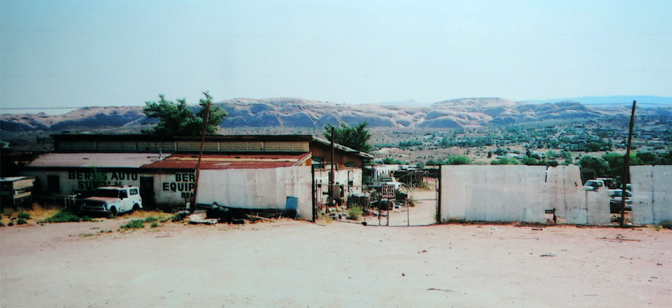
Having heard the rumors of junk yard extinction, I started taking photographs of the remaining auto graveyards, just as I had photographed the disappearing orchards a decade earlier. And so below are some memories of Bert’s. I have to admit I got a late start and many of the classic old auto wrecks had already made their way to the car shredder that had been set up 10 miles south of Moab at the far end of Spanish Valley.
Bert Swink started the auto graveyard and surplus parts store back in the 1950s and was highly successful. Bert turned over the operation in the 1980s to his son Don. Bert died in 2000 and Don passed away just a year later. Bert’s other son son Kerry, who had also worked for his father most of his life, continued the tradition for a few more years. It was said that if a customer came by, looking for a specific part, even if the car was 20 years old, Kerry knew just where to find it.
Eventually, in 2007, the property was sold and there is not a trace of the buildings or all those wonderful junk cars… Its an empty lot, no doubt waiting for the next motel or condo development…JS
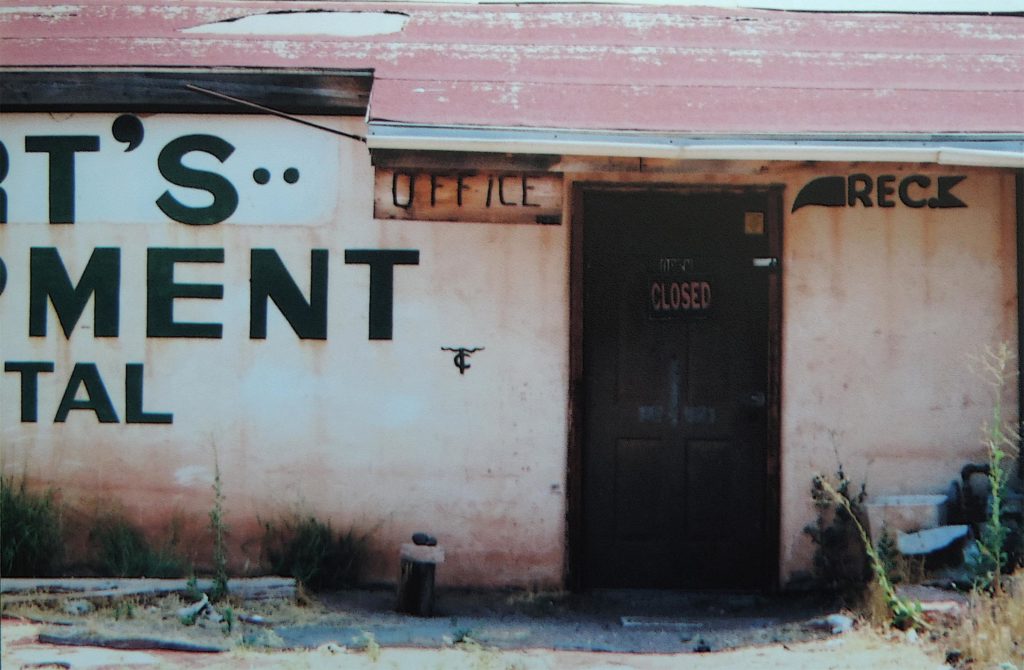
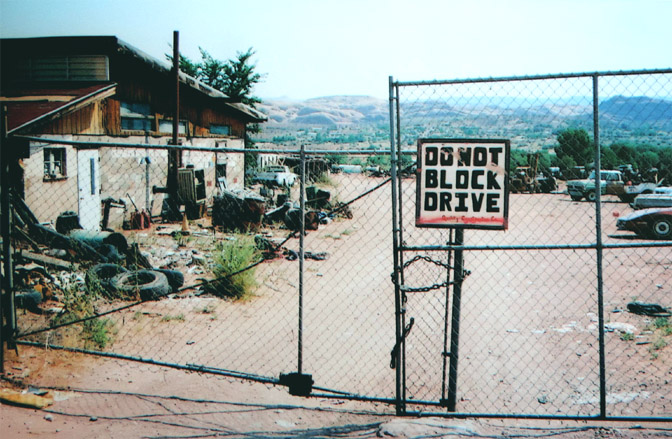
BELOW is part of an essay I wrote about the value of junk and how almost everyone thought it was a crazy idea…until a couple decades later, when some wondered if they might prefer a junk car to a massive condo development…
THE REJECTED PLAN TO SAVE MOAB…
(From 2002: “Could Junk be the Salvation of Moab?”)
It was an old friend of mine, an aging hippie/philosopher who first defended junk as the “Last Bastion of Defense Against Rich Weasel Yupster Developers” and a means of controlling Growth and keeping property taxes at a reasonable level. Known locally as Uncle Meat, he believed that no urban upper middle class American would be caught dead living next to a shabby tin trailer with pigs in a wallow out back and every car they’ve owned since 1957 parked out front and with a healthy portion of old refrigerators and discarded batteries tossed in (and about) for good measure.
Rural Westerners have always coveted their junk, long before it became a tool to discourage new neighbors. Perhaps because the distances are so great in the West (or were at least), getting replacement parts for just about any appliance or vehicle could be costly, difficult to find, and when located, might take weeks to arrive. So if the family car went kaput, it made sense to “store” it in the weeds and see what use it might provide in the future. After all, just because the engine threw a rod didn’t mean there was a thing wrong with the transmission or the differential or any number of other still functioning parts. The next car just might be able to use some of those parts. And if their new car wasn’t compatible with the junked one, a neighbor might have a use for it. Soon nobody threw away anything. That’s why miles of black pipe and conduit and brass fittings and washing machine motors and swamp coolers and practically anything you can imagine that once performed a task for Rural Westerners could be found in their backyards. And maybe they’re even a touch sentimental.
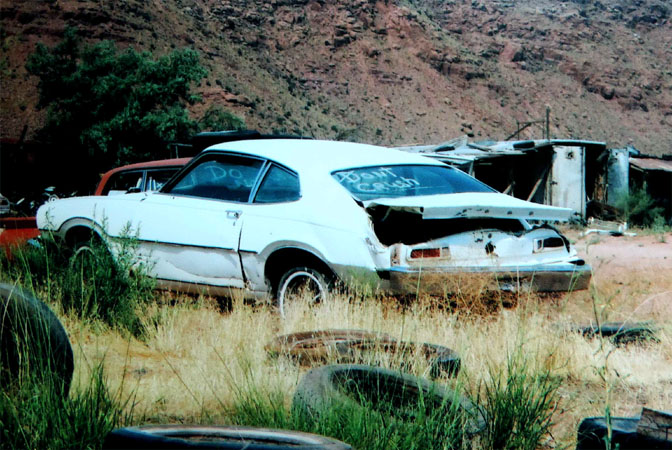
But there is a vital connection between all that lovely junk and maintaining a rural culture. It was proposed that, to hold the line against out-of-town investors, mostly vacant condo developments (those dratted time-share people) and other ne’r-do-wells, the governing bodies of our community needed to take immediate and drastic action.
Specifically, our only hope was the enactment of a city and county ordinance that required the presence of junk in every Grand County resident’s yard. I cannot recall the exact details, but I believe the plan called for at least one prominently displayed inoperative vehicle on cinder blocks, three door-less defunct refrigerators, and 500 square feet (minimum) of waist deep weeds, preferably noxious, per front yard. Back yard junk was optional since it wasn’t always clearly visible from the road. And Uncle Meat mentioned tax incentives for homeowners who maintained smelly farm animals in small pens.
At first glance, this idea might strike some as unusual, and to others downright extreme. But this is Utah after all. In other communities across my beloved Beehive State, city councils and county commissions have endorsed and approved all kinds of far nuttier ideas. Some have passed ordinances that mandate the wearing of firearms, for example, and in one community, the city council voted to require a sign in every resident’s yard condemning the United Nations. By comparison, a pro-junk ordinance would have been quite mild, even tepid by Utah standards.
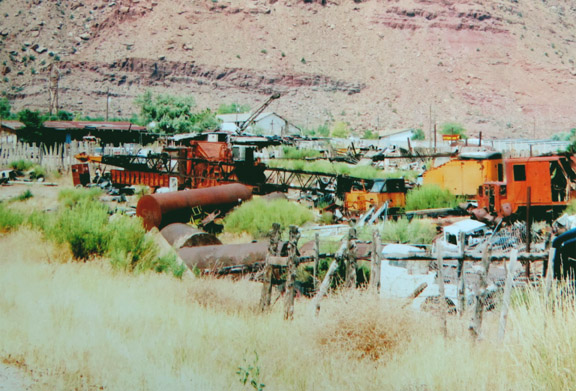
But the vision never came to pass; instead we were all slowly outnumbered by an influx of new Grand County residents with an urban past, who had a habit of buying land next to junky yards, or farm animals, knowing the junk or the smell was there, supposedly accepting and even embracing Life In Moab the way it was, then weeks or months later, getting annoyed, then angry, then hysterical about the offending view or odor. It was the same story. The new neighbor might try being perfunctorily pleasant the first time (“Uh…excuse me? But the odor from your pigs are really making it impossible for me to enjoy my tofu dinner…could you do something about that please?” Like what? Change their deodorant?).
When the farmer looked at them blankly, shook his head and walked away, the newcomers might ratchet it up a bit with a letter to the health department. Usually that didn’t work either. All the new resident could do was wait for a demographic shift. In places like Moab it didn’t take long. Today, Grand County moves forward to implement new anti-junk ordinances, the antithesis of our Junky Dream, but has sweetened the deal by offering to pay for the removal, instead of threatening fines. Even many of the old-timers, tired of fighting what feels like inevitable restrictions on their old lifestyle, and seduced by exploding real estate prices, have figured out that junk-free yards get a better price. They know their days are numbered–-might as well take the money and run.
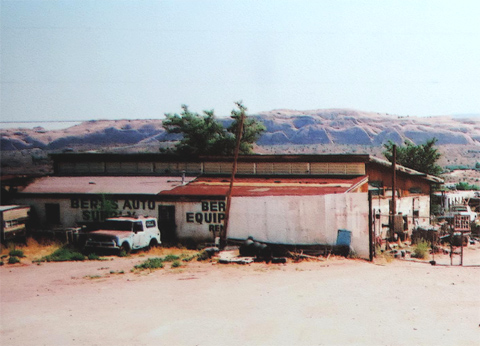
Spanish Valley Drive was once a funky mishmash of trailers and homemade cabins and rundown ranch-style leftovers from the Uranium Boom. Today they’re giving way to high density planned urban units, built out of cheap wood, polyfoam insulation, chicken wire and stucco. They squeeze as many of them to the acre as the planning commission will allow and call them homes. But nobody knows their neighbors, everyone locks their doors and burglar alarms are standard equipment. But if you need a spare tie rod end for a ‘73 Buick, don’t count on anyone to help you out.
Some will argue that the explosive growth of small towns like Moab is inevitable, that it’s happening all over the Rural West and that to fight it is a hopeless waste of time, energy and ultimately will cause heartbreak and disillusionment. And yet no small town has ever shown more courage and determination than Moab when it wanted to. Moab is the living proof that we could have stopped what’s happening to it now.
Jim Stiles is publisher/editor of The Zephyr

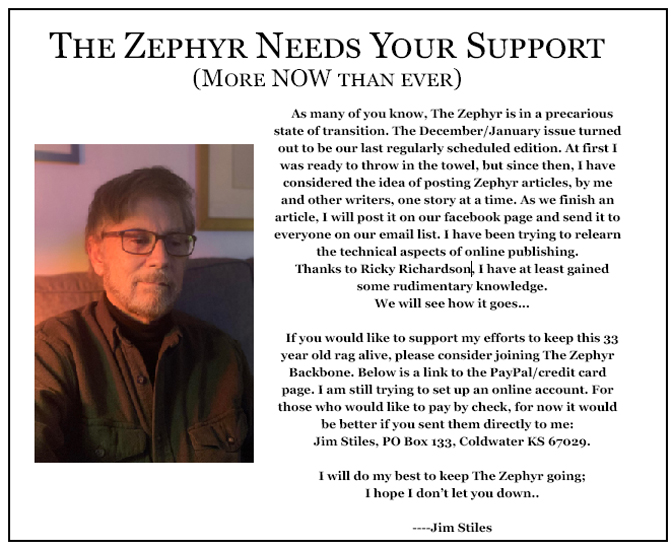

the halcyon moab herein described reminds me of a few present-day places around the “Grand Valley” — e.g., Whitewater (where i reside), Clifton, Orchard Mesa …
As young teenager growing up in Moab in the 50’s and 60’s I was a frequent visitor to Bert’s auto salvage yard. I always found what I needed to keep my old hot rod running.
There was and there is no way to keep the march of industrial strength amenities tourism from invading and occupying the southwest. First Moab, then Monticello then Blanding and now the tiny hamlet of Bluff which has already become unaffordable for those who work there. You can add most of the intermountain states in the west to the list where this is happening.
The only solution is to move to a rural town in Kansas, which was just awarded last place in an article about the top fifty scenic states, or perhaps one of it’s “non-scenic” neighboring states. As someone who was raised in Kansas, I’m just glad the sunflower state made it into the top fifty. 🙂
I must admit, back in about 2005, I was aghast at the number of old junk yards in and around Moab. Now that Swink’s, Tom Toms and old Lions Club Park are gone, I miss them all dearly. I cannot find the photo now, but Tom Toms once sponsored VW Bug races on the Colorado River. Launching from somewhere near Lions Club Park, they featured empty 55-gal. oil drums lashed to their bottoms for floatation. Off they would go, floating down river. I’m not sure how they steered them or where they retrieved them, if at all.
During my 13 years in Moab, I bought many parts at Bert’s, which was just down the lane and across the highway from my house on South Arroyo Road. I remember fondly the day he helped me find a transmission for my International Harvester Travelall. Yes, he had one back there in that yard, saving me hundreds of dollars in transmission repair cost. His wrecking yard was indeed a Moab treasure. I also bought many parts from Tom Arnold at Tom Tom’s, another very unique Moab establishment.
Beautiful. Another gem of nostalgia for a Moab back before. The photos are great too. Thank you Jim. I love junkyards. They are harder to hide out in the west, I think. They aren’t so easily swallowed by elms or kudzu. So they inflict themselves on the eye more readily. Thus generating public retinal conscientiousness. Crusades against the culturing of rust.
I remember Tom-Tom’s VW junkyard well. But never got to lay eyes on the Swink Recycling Emporium. Tempus fugit.
No dog in this junkyard tho’?
I moved to Houston on 1/1/1973. It was a big city compared to Baton Rouge where I was born and raised. But, since then it has exploded with development and a proliferation of freeways and overpasses, toll roads and it is not as nice as when we moved here. The traffic, crowding, and crime has skyrocketed. I would never have come to live here as it is now. But I am old and stuck here. Sad
We still have junkyards or junky yards in Fredonia, and that helps distinguish us from Kanab. Sadly, given rising real estate prices, this will probably not last
Sounds just exactly like the destruction of a once beautiful place called Jackson, Wyoming
Bert was my grandpa and I spent many days playing in that junkyard. Going through old cars and playing in the yard. Once I was old enough to drive, my parents bought me a crappy 1974 pinto that went through several engines. When one went out, we got another from grandpa. It’s always sad to go to Moab now. It’s just not the Moab I remember.
I am the oldest son and have very fond memories
SWINK: In the Webster Dictionary: A word that means to work under difficult conditions for long hours.
My dad was given this nickname at the ESSO refinery in Baton Rouge where he worked for more than 30 years until he died suddenly at age 58. Never got to retire.
I must admit that at first this article surprised me a little. But then I realized that this garbage was an integral part of the face of Moab and gave it its own uniqueness. It is necessary to take into account the wishes of local residents, and not to destroy the history of the locality by imposing a new with urban improvements.
I remember the good Ole days at Bert’s Autu Supply.I was Bert’s oldest son and Bert had a salvage yard most of my life.He raised 4 kids and provided for as long as I can remember.
Thanks for the trip down memory lane at Bert Swink’s Auto Parts and junk yard. The debate on junk’s role in preserving rural culture is intriguing, and the rejected plan to save Moab through embracing junk adds a touch of humor to the changing landscape.